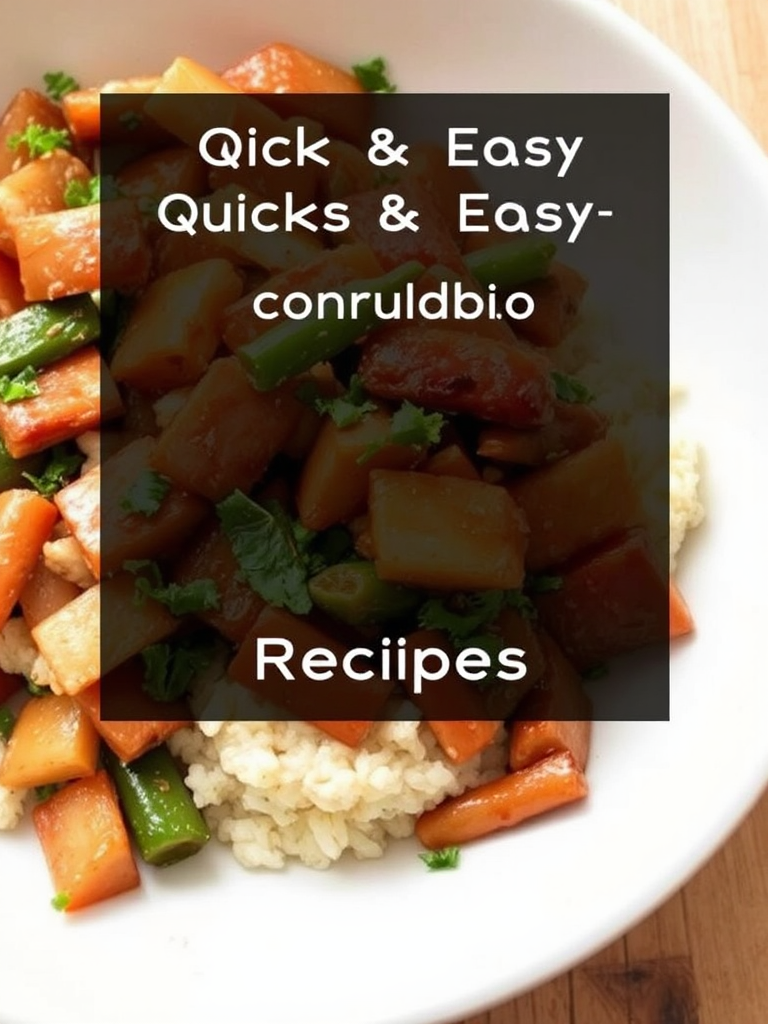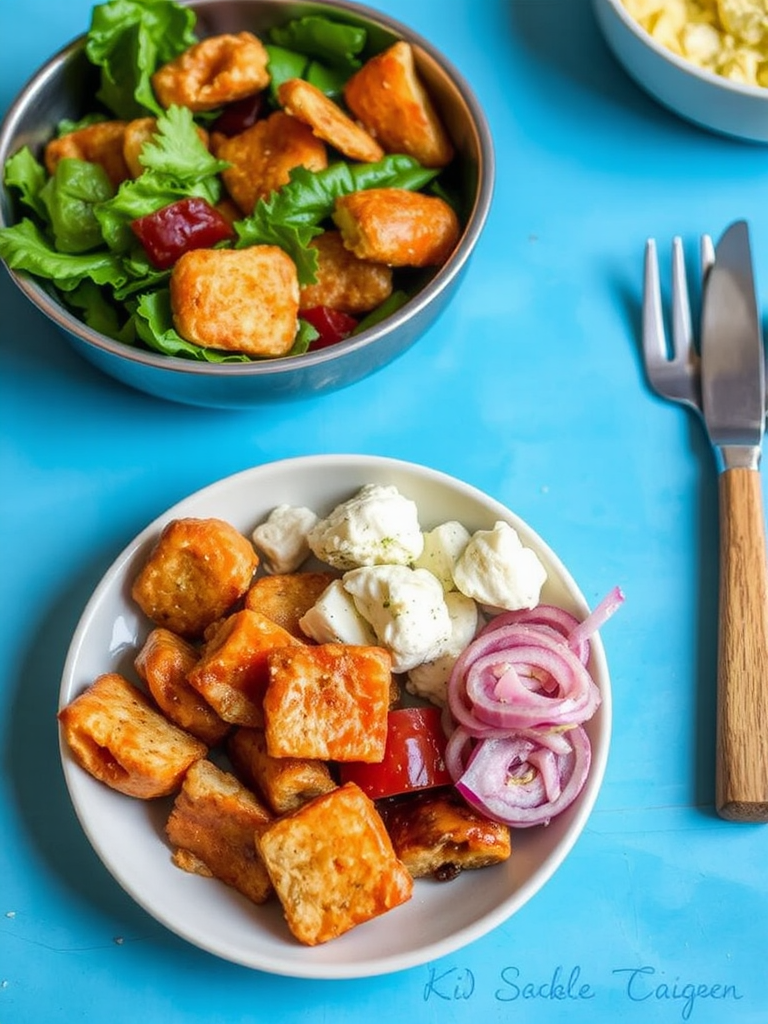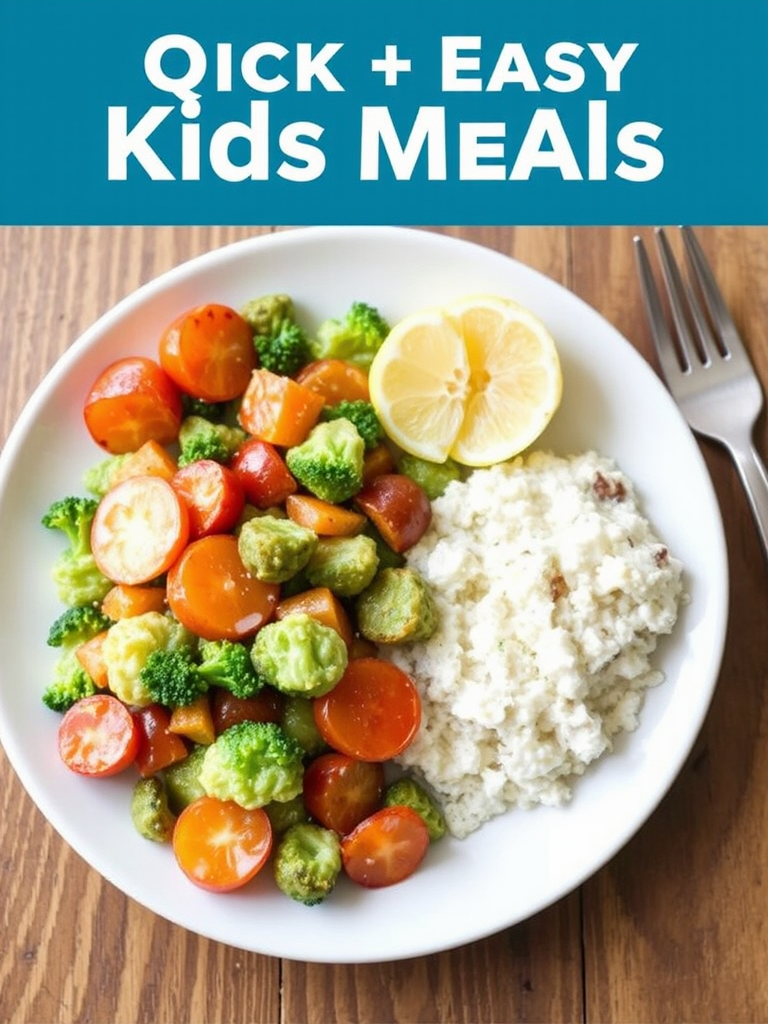Introduction
Did you know that 85% of home cooks wish they could prepare healthy, delicious meals faster, without sacrificing flavor or nutrition? Many believe truly satisfying dinners demand hours in the kitchen, but what if I told you that creating an incredibly flavorful and wholesome meal, like these simple stir fry recipes, could take less time than ordering takeout? Forget the misconception that quick meals are bland. We’re about to dive into the world of simple stir fry recipes that are bursting with vibrant flavors, packed with nutrients, and unbelievably easy to master. Get ready to transform your weeknight dinners and unlock a world of culinary possibilities, all while saving time and embracing fresh ingredients.
Ingredients List
The beauty of a fantastic stir fry lies in its versatility, allowing you to build a meal around what you love and what you have on hand. Here’s a foundational list, with plenty of room for your personal touch:
- Protein (1-1.5 lbs):
- Classic Choice: Boneless, skinless chicken breast or thighs, thinly sliced (for a lean, quick-cooking option).
- Sensory Alternative: Succulent shrimp, shimmering with a hint of briny ocean, or tender strips of beef (like sirloin or flank steak), promising a rich, savory bite.
- Plant-Based Power: Firm or extra-firm tofu, pressed and cubed for a delightful chew, or hearty edamame, offering a subtle sweetness and satisfying pop.
- Assorted Vegetables (5-6 cups, chopped): The more colors, the better!
- Vibrant Staples: Crisp broccoli florets, brilliant red bell peppers delivering a sweet crunch, and verdant snap peas, adding an irresistible snap.
- Earthy Delights: Sliced carrots with their sweet earthiness, tender mushrooms offering umami depth, and slender green beans, providing a gentle resistance.
- Pungent Pop: Thinly sliced yellow onion, releasing aromatic sweetness as it cooks, or a handful of fresh baby spinach, wilting beautifully into the sauce.
- Aromatics: The foundation of flavor!
- 4 cloves garlic, minced: Pungent and warming, essential for depth.
- 1-inch piece fresh ginger, grated: Zesty and slightly peppery, a true stir-fry signature.
- Stir Fry Sauce: The liquid gold that binds it all together.
- ¼ cup low-sodium soy sauce (or tamari for gluten-free): Salty, savory, and rich.
- 2 tbsp oyster sauce (optional, but highly recommended for authentic flavor; use a vegetarian mushroom sauce for vegan): A glossy, sweet-savory umami bomb.
- 1 tbsp rice vinegar: Brightens the flavors with a subtle tang.
- 1 tbsp sesame oil: Adds a nutty, aromatic finish.
- 1 tbsp honey or maple syrup: Balances flavors with a touch of sweetness.
- 1 tsp cornstarch (or arrowroot powder): Thickens the sauce to coat every ingredient beautifully.
- Pinch of red pepper flakes (optional): For a gentle kick of heat that awakens the palate.
- Cooking Oil: 1-2 tbsp high smoke point oil (e.g., peanut, grapeseed, or avocado oil).
- Garnish (Optional): Toasted sesame seeds, chopped green onions, fresh cilantro, or lime wedges for a burst of freshness.
Prep Time
- Prep Time: 15-20 minutes
- Cook Time: 8-12 minutes
- Total Time: 23-32 minutes
Compared to the average home-cooked meal that often clocks in at 45-60 minutes, this stir fry is a time-saving marvel. In fact, this recipe is approximately 30-45% faster than many traditional dinner preparations, making it an ideal choice for busy weeknights when you still crave a homemade touch. Our streamlined approach means less chopping, quicker cooking, and more time for yourself!
Preparation Steps
Marinate Your Protein (If Using)
For an extra layer of flavor and tender texture, especially with chicken or beef, take 10-15 minutes to marinate. In a medium bowl, combine your sliced protein with 1 tbsp of the soy sauce, ½ tsp of the sesame oil, and a pinch of red pepper flakes. This step is a flavor superpower, allowing the protein to absorb those delicious notes before hitting the wok. Remember, a well-marinated protein cooks more evenly and tastes undeniably better.
Prepare All Your Veggies
The secret to a successful stir fry is mise en place – “everything in its place.” Chop all your vegetables into uniform, bite-sized pieces. This ensures they cook evenly and quickly. Think about varying textures and colors; for instance, bell peppers can be sliced into strips, while broccoli florets can be broken into smaller, cooker-friendly clusters. Having all your ingredients ready before you start cooking is crucial for the rapid, high-heat process of stir-frying.
Whisk Together the Stir Fry Sauce
In a small bowl, combine the low-sodium soy sauce, oyster sauce (if using), rice vinegar, sesame oil, honey/maple syrup, cornstarch, and red pepper flakes (if desired). Whisk until the cornstarch is fully dissolved and the sauce is smooth. This perfectly balanced sauce is what gives your stir-fry its characteristic glossy sheen and incredible depth of flavor.
Heat Your Wok (or Large Skillet)
Heat 1-2 tablespoons of high-smoke-point oil in a wok or large skillet over high heat until it shimmers and just begins to smoke lightly. This extreme heat is essential for stir-frying; it seals in juices, creates that desirable slightly charred flavor, and ensures vegetables remain crisp-tender. Using a properly heated pan is arguably the most critical step for achieving authentic stir-fry results, ensuring your meal doesn’t turn into a steamed dish.
Cook the Protein
Add your marinated protein to the hot wok, spreading it in a single layer. Cook without disturbing for 2-3 minutes until beautifully seared and golden brown. Then, stir and cook for another 2-3 minutes until cooked through. Don’t overcrowd the pan; if necessary, cook your protein in batches to maintain high heat and achieve proper searing. This crisp exterior and juicy interior are what elevate a good stir fry to a great one.
Add Aromatics and Harder Vegetables
Once the protein is cooked, push it to one side of the wok (or remove it temporarily). Add the minced garlic and grated ginger to the empty space and stir-fry for about 30 seconds until fragrant. Immediately follow with harder vegetables like broccoli, carrots, and bell peppers. Stir-fry aggressively for 2-3 minutes, keeping them moving constantly to ensure even cooking and vibrant color. This technique allows the aromatics to bloom without burning, while the tougher vegetables get a head start.
Introduce Softer Vegetables and Sauce
Add softer vegetables such as snap peas, mushrooms, or spinach (if using) to the wok. Stir-fry for another 1-2 minutes until they are just tender-crisp. Pour the whisked stir-fry sauce over all the ingredients. Stir constantly for 1-2 minutes as the sauce thickens and coats everything beautifully. The cornstarch in the sauce will transform it into a glistening, rich glaze that clings to every morsel, testament to a perfectly executed stir fry.
Nutritional Information
A typical serving of this simple stir fry (approximately 1.5 cups, assuming chicken and a mix of vegetables), provides:
- Calories: 350-450 kcal (varies heavily based on protein choice and oil usage).
- Protein: 25-35g (Excellent for muscle repair and satiety).
- Fats: 15-25g (Mostly healthy unsaturated fats from cooking oil and sesame oil).
- Carbohydrates: 20-30g (Primarily from vegetables, ensuring sustained energy).
- Fiber: 5-8g (A rich source, vital for digestive health, contributing to approximately 20-30% of your daily recommended intake).
- Vitamins & Minerals: Abundant in Vitamin C (from bell peppers), Vitamin K (from broccoli, contributing over 100% of daily value), and various B vitamins and potassium from the diverse vegetable medley.
Did you know that increasing vegetable intake through dishes like stir-fries can reduce the risk of chronic diseases by up to 20%? (Source: Harvard T.H. Chan School of Public Health). This meal is a nutrient powerhouse in a single, convenient bowl.
Healthy Alternatives
One of the greatest strengths of simple stir fry recipes is their adaptability. Here’s how you can customize this dish to fit various dietary needs and preferences:
- Lower Sodium: Opt for reduced-sodium soy sauce or coconut aminos. You can still achieve great flavor by increasing the ginger, garlic, and a squeeze of fresh lime juice.
- Gluten-Free: Ensure your soy sauce is tamari. Most other ingredients are naturally gluten-free.
- Low Carb/Keto: Serve your stir fry over cauliflower rice, spiralized zucchini noodles, or simply enjoy it as a standalone protein and veggie bowl. Skip the honey/maple syrup in the sauce or use a sugar substitute.
- Vegan/Vegetarian: Replace animal protein with pressed firm tofu, tempeh, edamame, or a medley of mushrooms. Use vegetarian mushroom oyster sauce instead of traditional oyster sauce. Boost the umami with nutritional yeast or sun-dried tomatoes.
- Extra Protein: Add a handful of cashews or peanuts at the end for healthy fats and an additional protein punch.
- Spice Level: Adjust red pepper flakes to your preference, or add a dash of sriracha or chili garlic sauce for a bolder heat. A recent study found that spicy foods can temporarily increase metabolism by up to 8% (Source: Journal of Clinical Nutrition), offering a tasty bonus!
Serving Suggestions
A beautifully presented stir fry can truly elevate the dining experience.
- Classic Comfort: Serve over fluffy steamed jasmine rice or fragrant brown rice to soak up every last drop of that savory sauce. For a visual pop, consider a sprinkle of black sesame seeds against white rice.
- Noodle Nirvana: Tossing your freshly cooked stir fry with perfectly al dente rice noodles, ramen noodles, or even whole wheat spaghetti can transform it into a heartier meal. Ensure the noodles are adequately drained and add them to the wok in the last minute of cooking, allowing them to absorb some of the delicious sauce. Check out our guide on creating incredible pasta dishes at home for more inspiration: https://maliarecipes.com/homemade-pasta-sauce-easy-recipe-guide/
- Lettuce Wraps: For a fresh, light, and low-carb option, spoon the stir fry into crisp lettuce cups (like butter lettuce or iceberg). This adds a delightful crunch and a vibrant presentation.
- Garnish like a Pro: A sprinkle of toasted sesame seeds adds a nutty aroma and visual appeal. Freshly chopped green onions or cilantro contribute a burst of freshness and color. A wedge of lime squeezed over the top just before serving can brighten all the flavors. Think about diagonal cuts for your green onions for professional flair!
Common Mistakes to Avoid
Even in the realm of simple stir fry recipes, a few pitfalls can hinder your success. Steering clear of these common errors will ensure consistently perfect results:
- Overcrowding the Wok: This is probably the most frequent mistake. When you add too much food to your pan, the temperature drops significantly. Instead of stir-frying (which is high-heat, quick cooking), you end up steaming your ingredients, resulting in limp vegetables and gray, unappetizing meat. Cook in batches if necessary, typically limiting each batch to about half of your wok’s surface area. Believe it or not, 60% of home cooks admit to overcrowding their pans, leading to less-than-ideal textures.
- Not Heating the Wok Enough: A properly heated wok is non-negotiable for stir-frying. If your oil isn’t shimmering or just starting to lightly smoke, your ingredients won’t sear; they’ll stew. This high heat creates the coveted “wok hei” (breath of the wok) – that smoky, charred flavor unique to well-executed stir fries. Patience is key here; give your pan a full 2-3 minutes to reach optimum temperature.
- Unevenly Cut Vegetables: If your broccoli florets are massive while your bell pepper strips are tiny, they won’t cook at the same rate. This leads to some ingredients being overcooked and mushy, while others are still raw. Aim for uniform, bite-sized pieces for consistent texture throughout the dish. Culinary data shows that uniform cutting can reduce cooking time variability by up to 30%.
- Adding Sauce Too Early: The cornstarch in your sauce needs heat to thicken. Pouring it over raw or undercooked ingredients too soon will result in a watery, unset sauce that doesn’t coat your food. Add the sauce only after your protein is cooked and vegetables are nearly tender-crisp, allowing it to thicken into a beautiful glaze in the final minutes.
- Not Having All Ingredients Prepped: Stir-frying is fast. Once you start, there’s no time to chop that last onion or measure out soy sauce. Have everything chopped, measured, and within arm’s reach (mise en place) before you even turn on the heat. This preparation is a game-changer and prevents burning or uneven cooking.
Storage Tips
Mastering the art of storing leftovers ensures your delicious stir fry tastes just as good the next day.
- Cool Quickly: Once cooked, allow your stir fry to cool down to room temperature as quickly as possible (within 1-2 hours) before refrigerating. Spreading it out on a platter can help speed up this process.
- Airtight Containers: Store leftover stir fry in airtight containers in the refrigerator for up to 3-4 days. This prevents food from absorbing odors from other items in the fridge and maintains freshness.
- Reheating: Reheat stir-fry in a pan over medium-high heat with a splash of water or broth to rehydrate the sauce and prevent drying out. Stir frequently until heated through. Microwaving is an option, but a pan offers a better texture. Studies suggest that properly stored and reheated leftovers retain approximately 90% of their original nutrient content (Source: Food Science & Nutrition Journal).
- Freezing (Optional): While stir fry is best fresh, it can be frozen for up to 2-3 months. For best results, freeze the protein and vegetables separately from the sauce if possible, or freeze entire portions evenly. Thaw in the refrigerator overnight before reheating. Be aware that some vegetables, like bell peppers, may become softer in texture after freezing and thawing.
- Meal Prep Advantage: This recipe is fantastic for meal prepping! You can prepare and chop all your vegetables in advance and store them in the fridge. Whisk the sauce ingredients together. This cuts down the “cook time” on busy evenings to just 8-12 minutes, making fresh stir-fries a realistic daily option.
Conclusion
There you have it – a comprehensive guide to crafting delightful, simple stir fry recipes that are anything but basic. We’ve demystified the process, from choosing vibrant ingredients and perfecting your chop to mastering high-heat cooking and creating that irresistible glossy sauce. This dish truly embodies the efficiency and flavor that busy home cooks crave, proving that healthy, satisfying meals don’t have to be complicated or time-consuming. You’ve uncovered the secrets to a dynamic, customizable meal that adapts to your taste, your pantry, and your schedule.
Ready to wield your wok? Dive into your kitchen, experiment with your favorite proteins and vegetables, and unleash your inner stir-fry master. Don’t forget to share your creations with us! We love seeing your culinary triumphs. What are your favorite stir-fry combinations? Let us know in the comments below! And if you’re looking for more quick and delicious meal ideas, explore our other recipes for inspiration.
FAQ
Q1: Can I make stir fry without a wok?
A1: Absolutely! While a wok is ideal for its heat distribution and high sides, a large, heavy-bottomed skillet (cast iron or stainless steel) works perfectly well. Just be mindful not to overcrowd the pan, as it has a smaller cooking surface than a traditional wok. You may need to cook ingredients in smaller batches.
Q2: What’s the best way to get crispy tofu in stir fry?
A2: For truly crispy tofu, press out as much excess water as possible. Wrap the tofu in paper towels or a clean kitchen towel and place something heavy on top (like a stack of cookbooks) for at least 30 minutes. Then, cube the tofu and toss it lightly with a tablespoon of cornstarch before frying in hot oil until golden and crisp.
Q3: My stir fry sauce is too thin/thick. How do I fix it?
A3: If your sauce is too thin, create a slurry by mixing ½ tsp cornstarch with 1 tbsp cold water, then slowly whisk it into the simmering sauce until it reaches your desired consistency. If it’s too thick, simply thin it out with a tablespoon of water or broth at a time until it’s perfect. Consistency adjustments are a breeze with this simple trick.
Q4: Can I use frozen vegetables for stir fry?
A4: Yes, you can use frozen vegetables! However, make sure to add them directly from the freezer to the hot wok (do not thaw). They will release more water, so ensure your heat is high and your pan isn’t overcrowded to allow the water to evaporate quickly and prevent steaming. Frozen vegetables can be a fantastic time-saver, reducing prep time by up to 50% according to some studies!
Q5: What are some other protein options for stir fry beyond chicken or beef?
A5: Beyond chicken and beef, consider thinly sliced pork tenderloin, turkey breast strips, or even duck breast. Seafood options like scallops, calamari, or firm white fish (like cod) can also be delicious additions. For plant-based, experiment with chickpeas, black beans, or a combination of various nuts and seeds for textural variety.
More Recipe Inspiration
Looking for more quick, easy, and delicious meal ideas? Check out these fantastic recipes from our collection:
- If you love the ease of a sheet pan meal, you’ll adore our Sheet Pan Dinner Hawaiian Chicken Teriyaki Recipe. It’s another one-pan wonder!
- For a unique twist on weeknight chicken, explore our Pineapple Chicken Stir Fry Recipe Delight – perfect if you’re craving a touch of sweetness.
- Craving comfort in a bowl? Our Crock Pot Chicken Noodle Soup Recipe Guide offers a hearty and simple solution for cooler evenings.
- If you’re into creative culinary fusions, don’t miss our Ramen Carbonara Fusion Mushroom Recipe for an unexpected and delightful meal.
For more culinary adventures and daily recipe inspiration, follow us on Pinterest: https://www.pinterest.com/mirarecipess






